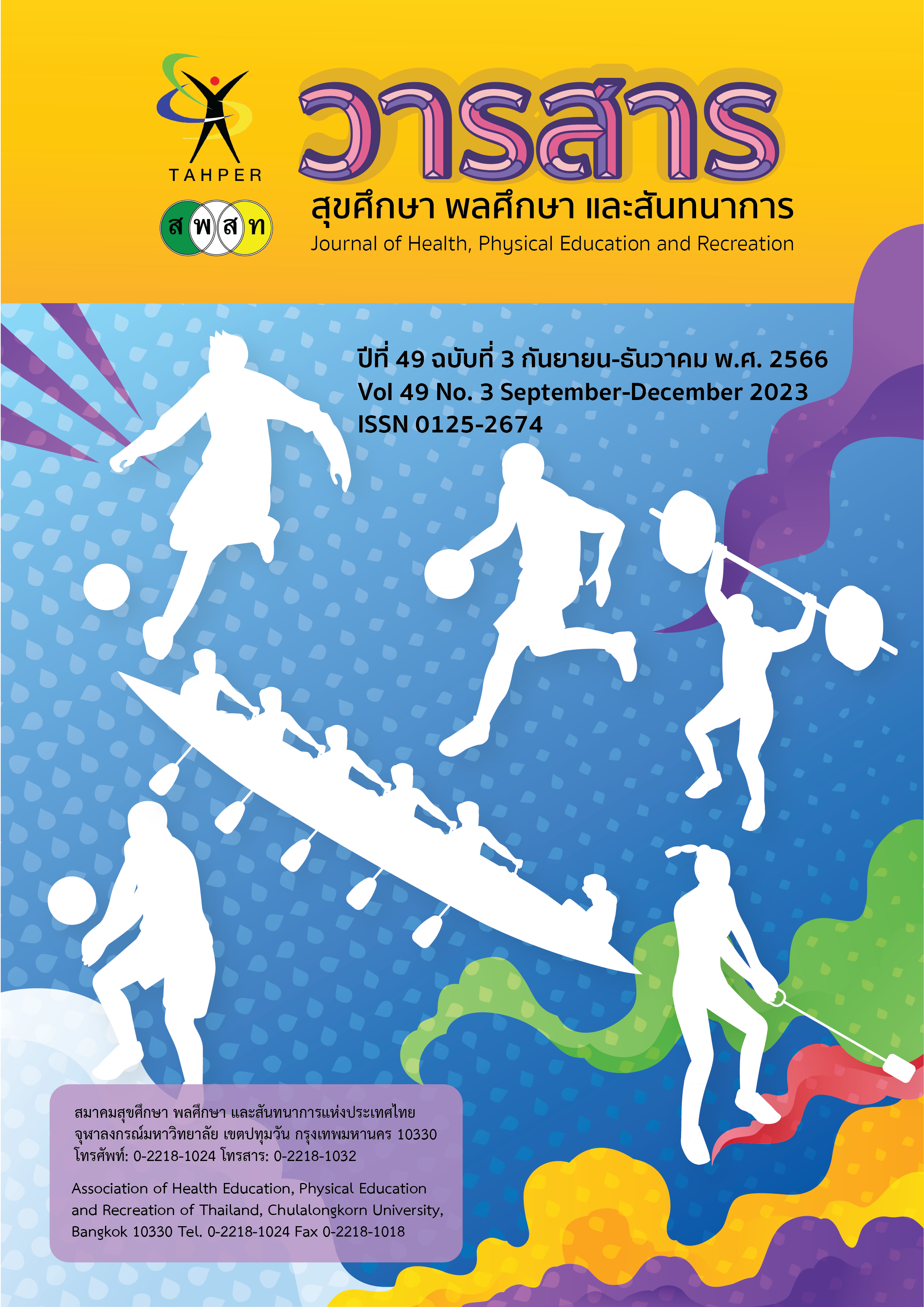Relationship Between Health Locus of Control with Health Behavior and Quality of Life of Teachers in Buriram Province
Main Article Content
Abstract
This descriptive study was aimed to examine the health locus of control, health behavior, quality of life, and the interplay among all of the three variables of teachers working in the Buriram province. The sample was composed of 400 teachers who are currently working in the Buriram province. The data was collected by adopting a questionnaire, including questions about health locus of control, health behavior and the overall quality of life. The results showed correlation indices of 0.93, 0.92, and 0.97, respectively, and questionnaire validity values of 0.92, 0.86, and 0.90, respectively. The data was then analyzed by means of basic statistics, including the usage of average and percentage calculations, the standard deviation, and the Pearson’s correlation coefficient.
The research results were as follows: 1) The teachers overall health locus of control level was classified as low, consisting of a high level of internal locus of control, and a low level of external health locus of control. Furthermore, their health behavior level was classified as high, while their quality of life was measured to be equal to that of the average level. 2) With a statistical significance level of 0.05, there was a weak positive correlation between the teacher’s health locus of control and their health behavior. Moreover, with a statistical significance level of 0.01, there was a weak positive correlation between teacher’s health locus of control and their measured quality of life.
In conclusion, the majority of the sampled teachers were associated with a low level of health locus of control. Therefore, the study suggests that there should be more focus on increasing the teacher’s level of health locus of control. In addition, this could potentially improve their health behavior and their quality of life as well.
Article Details

This work is licensed under a Creative Commons Attribution-NonCommercial-NoDerivatives 4.0 International License.
Critical thinking in journals is the right of the author. The Association of Health Education, Physical Education and Recreation of Thailand is not always required, to create diversity in ideas and creativity.
ความคิด ข้อวิพากษ์ในวารสารเป้นสิทธิของผู้เขียน สมาคมสุขศึกษา พลศึกษา และสันทนาการแห่งประเทศไทยไม่จำเป็นต้องเห็นชอบด้วยเสมอไป เพื่อให้เกิดความหลากหลายในความคิดและความสร้างสรรค์
References
จินตนา สรายุทธพิทักษ์. (2561). โปรแกรมสุขภาพในโรงเรียน. (พิมพ์ครั้งที่ 3). กรุงเทพฯ: โรงพิมพ์จุฬาลงกรณ์มหาวิทยาลัย.
ชโลธร เสียงใส และสุจิตรา สุคนธทรัพย์. (2558). ปัจจัยที่มีความสัมพันธ์กับการมีกิจกรรมทางกายของนิสิตนักศึกษาสถาบันอุดมศึกษาในกรุงเทพมหานคร. วารสารวิทยาศาสตร์การกีฬาและสุขภาพ, 16(3). 63-75.
ชัยนาท ตั้งสุวรรณกุล. (2555). การอบรมโครงการเมืองน่าอยู่. ชลบุรี: ศูนย์อนามัยและสิ่งแวดล้อม.
ไทยรัฐออนไลน์. (2554). โรคภัยไข้เจ็บรุมเร้าคร่าชีวิตแม่พิมพ์อื้อ. สืบค้นเมื่อ 11 พฤษภาคม 2561, สืบค้นจาก https://www.thairath.co.th/content/191645
ไทยรัฐออนไลน์. (2556). เตือน ‘5 โรคร้าย’ อันตรายต่อ ‘ครู’ แนะเทคนิคดูแลสุขภาพ. สืบค้นเมื่อ 11 พฤษภาคม 2561, สืบค้นจาก thairath.co.th/content/320315
นิตยา พรมพินิจ, วัลนิกา ฉลากบาง และพิศุทธิ์ กิติศรีวรพันธุ์. (2558). การพัฒนาตัวบ่งชี้คุณภาพชีวิตครู สังกัดสำนักงานเขตพื้นที่การศึกษาประถมศึกษาสกลนครเขต 2. วารสารมหาวิทยาลัยนครพนม, 5(3). 42-47.
พรรณี ปานเทวัญ. (2533). ความสัมพันธ์ระหว่างความเชื่ออำนาจภายใน – ภายนอกตน ด้านสุขภาพอนามัย ปัจจัยพื้นฐานบางประการกับแบบแผนการดำเนินชีวิตของ คนงานหญิงโรงงานอุตสาหกรรมสิ่งทอใน เขตอำเภอเมือง จังหวัดสมุทรปราการ. วิทยานิพนธ์ปรญญามหาบัณฑิต สาขาพยาบาลศาสตร์, มหาวิทยาลัยมหิดล.
พระราชบัณณัติสุขภาพแห่งชาติ. (2550). ราชกิจจานุเบกษา เล่มที่ 124 ตอนที่ 16 ก. สืบค้นเมื่อ 11 พฤษภาคม 2561, สืบค้นจาก http://web.krisdika.go.th/data/law/law2/%CA71/%CA71-20-9999-update.pdf
พวงทอง ป้องภัย. (2540). พฤติกรรมศาสตร์เบื้องต้น. ปัตตานี: ภาควิชาพลศึกษา, คณะศึกษาศาสตร์ มหาวิทยาลัยสงขลานครินทร์ วิทยาเขตปัตตานี.
สนุก สิงห์มาตร, พิกุล มีมานะ และธีรภัทร์ ถิ่นแสนดี. (2560). คุณภาพชีวิตตามวิถีปรัชญาของเศรษฐกิจพอเพียงสำหรับครูและบุคลากรทางการศึกษาในพื้นที่จังหวัดยโสธร. วารสารสถาบันวิจัยและพัฒนา มหาวิทยาลัยราชภัฏมหาสารคาม, 4(2). 147-160.
สโรชา อยู่ยงสินธุ์ และสุจิตรา สุคนธทรัพย์. (2558). ความสัมพันธ์ระหว่างความเชื่ออำนาจควบคุมทางสุขภาพกับพฤติกรรมสุขภาพและคุณภาพชีวิต ของผู้สูงอายุในภาคตะวันออกเฉียงเหนือ. วารสารวิทยาศาสตร์การกีฬาและสุขภาพ, 16(2). 73-86.
สำนักงานศึกษาธิการจังหวัดบุรีรัมย์. (2561). ข้อมูลรายงาน : จำนวนสถานศึกษา นักเรียน ครู และห้องเรียนจำแนกรายอำเภอและสังกัด ปีการศึกษา 2560. สืบค้นเมื่อ 11 พฤษภาคม 2561, สืบค้นจาก http://eduwh.moe.go.th/pub/report/stat/?cmd=report&year=2560& rep=3&zone=&prov=31&div=&area=
สุภัชฌาน์ ศรีเอี่ยม, อังคนา กรัณยาธิกุล, กนกวรรณ ปานสุขสาร และสายนภา วงศ์วิศาล. (2562). รูปแบบกิจกรรมกลุ่มสัมพันธ์เพื่อส่งเสริมคุณภาพชีวิตของเด็ก เยาวชน และครูในเขตเทศบาลตำบลโคกสูง จังหวัดสระแก้ว. วารสารบัณฑิตศึกษา มหาวิทยาลัยราชภัฏวไลยอลงกรณ์ ในพระบรมราชูปถัมภ์, 13(3). 149-162.
สุวัฒน์ มหัตนิรันดร์กุล และคณะ. (2540). เปรียบเทียบแบบวัดคุณภาพชีวิตขององค์การอนามัยโลกทุก 100 ตัวชี้วัด และ 26 ตัวชี้วัด. เชียงใหม่: โรงพยาบาลสวนปรุง.
อรชา อุดม และสำเริง อ่อนสัมพันธุ์. (2562). คุณภาพชีวิตการท างานของครูโรงเรียนวัดหวายเหนียว “ปุญสิริวิทยา” จังหวัดกาญจนบุรี. วารสารการบริหารการศึกษา มหาวิทยาลัยศิลปากร, 10(2). 1005-1017.
อิ่มทิพย์ อนิศดา และประเสริฐ อินทร์รักษ์. (2555). คุณภาพชีวิตของครูที่ส่งผลต่อการปฏิบัติงานตามมาตรฐานวิชาชีพครูในโรงเรียน สังกัดสำนักงานเขตพื้นที่การศึกษาประถมศึกษากาญจนบุรี เขต 4. วารสารบริหารการศึกษามหาวิทยาลัยศิลปากร, 3(1). 77-86.
Jimenez, D.E., et al. (2016). Health behavior change benefits: Perspectives of Latinos with serious mental illness. Transcultural Psychiatry, 53(3). 313-329.
Octari, T.E., Suryadi, B., & Sawitri, D.R. (2020). The role of self-concept and health locus of control on quality of life among individuals with diabetes. Jurnal Psikologi, 19(1). 80-94.
Pender, N.J. (1987). Health Promotion in nursing practice. (2nd ed.). New York: Appleton & Lange.
Pourhoseinzadeh, M., Gheibizadeh, G., Moradikalboland, M., & Cheraghian, B. (2017). The Relationship between Health Locus of Control and Health Behaviors in Emergency Medicine Personnel. IJCBNM, 5(4). 397-403.
Rotter, J.B. (1996). Generalization Expectancies for Internal Versus External Control of Reinforcement. Psychological Monographs: General and Applied, 80(1). No. 609.
Sharif, S.P. (2017). Locus of control, quality of life, anxiety, and depression among Malaysian breast cancer patients: The mediating role of uncertainty. European Journal of Oncology Nursing, 27, 28-35.
Strickland, B.R. (1978). Internal-External Control of Reinforcement in Personality Variables in Social Behavioral. Edited by Thomas Blass. New York: John Wiley and Son.
Wallston, K.A., Wallston, B.S., & DeVellis, R. (1978). Development of the Multidimensional Health Locus of Control (MHLC) Scale. Health Educ Monogr, 6(2). 160-170.
West, L.M., Theuma, R.B., & Cordina, M. (2018). Health locus of control: Its relationship with medication adherence and medication wastage. Research in Social and Administrative Pharmacy, 14(11). 1015-1019.


